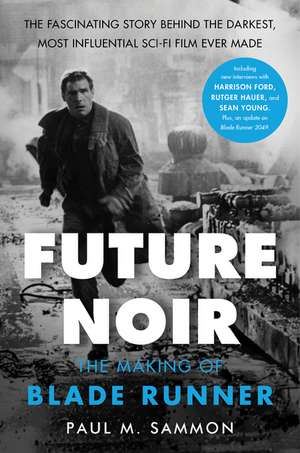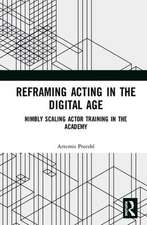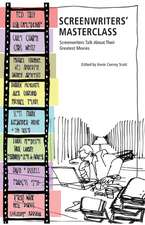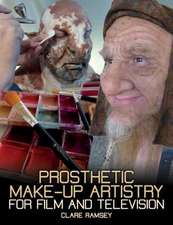Future Noir Revised & Updated Edition: The Making of Blade Runner
Autor Paul M. Sammonen Limba Engleză Paperback – 11 sep 2017
Ridley Scott’s 1992 "Director’s Cut" confirmed the international film cognoscenti’s judgment: Blade Runner, based on Philip K. Dick’s brilliant and troubling science fiction masterpiece Do Androids Dream of Electric Sheep?, is the most visually dense, thematically challenging, and influential science fiction film ever made. Future Noir offers a deeper understanding of this cult phenomenon that is storytelling and visual filmmaking at its best.
In this intensive, intimate and anything-but-glamorous behind-the-scenes account, film insider and cinephile Paul M. Sammon explores how Ridley Scott purposefully used his creative genius to transform the work of science fiction’s most uncompromising author into a critical sensation, a commercial success, and a cult classic that would reinvent the genre. Sammon reveals how the making of the original Blade Runner was a seven-year odyssey that would test the stamina and the imagination of writers, producers, special effects wizards, and the most innovative art directors and set designers in the industry at the time it was made. This revised and expanded edition of Future Noir includes:
- An overview of Blade Runner’s impact on moviemaking and its acknowledged significance in popular culture since the book’s original publication
- An exploration of the history of Blade Runner: The Final Cut and its theatrical release in 2007
- An up-close look at its long-awaited sequel Blade Runner 2049
- A 2007 interview with Harrison Ford now available to American readers
- Exclusive interviews with Rutger Hauer and Sean Young
Preț: 125.74 lei
Nou
24.06€ • 25.03$ • 19.87£
Carte disponibilă
Livrare economică 25 martie-08 aprilie
Livrare express 08-14 martie pentru 31.23 lei
Specificații
ISBN-10: 0062699466
Pagini: 624
Dimensiuni: 156 x 235 x 40 mm
Greutate: 0.68 kg
Editura: HarperCollins Publishers
Colecția Dey Street Books
Textul de pe ultima copertă
Ridley Scott’s 2007 “Final Cut” confirmed the international film cognoscenti’s judgment: Blade Runner, based on Philip K. Dick’s brilliant and troubling science fiction masterpiece Do Androids Dream of Electric Sheep?, is among the most visually dense, thematically challenging, and influential science fiction films ever made. Future Noir Revised & Updated Edition offers a deeper understanding of this cinematic phenomenon that is storytelling and visual filmmaking at its best.
In this intensive, intimate, and anything-but-glamorous behind-the-scenes account, film insider and cinephile Paul M. Sammon explores how Ridley Scott purposefully used his creative genius to transform the work of science fiction’s most uncompromising author into a critical sensation and cult classic that would reinvent the genre. Sammon reveals how the making of the original Blade Runner was a seven-year odyssey that would test the stamina and the imagination of writers, producers, special effects wizards, and the most innovative art directors and set designers in the industry at the time it was made. This revised and expanded edition of Future Noir includes:
- An overview of Blade Runner’s impact on moviemaking and its acknowledged significance in popular culture since the book’s original 1996 publication
- An exploration of the history of Blade Runner: The Final Cut and its theatrical release in 2007
- A look at its long-awaited sequel, Blade Runner 2049
- The longest interview Harrison Ford has ever granted about Blade Runner
- Exclusive new interviews with Rutger Hauer and Sean Young
Notă biografică
Paul M. Sammon's distinctive career can best be described by the film industry expression "hyphenate."
As a writer, Sammon has published numerous articles, short stories and books. His many film journalism pieces have seen print in The American Cinematographer, Cahiers du Cinema, The Los Angeles Times, Omni, Cinefex, and Cinefantastique. Sammon's fiction has appeared in Peter Straub's Ghosts (1995), and he recently edited both the 1994 "dead Elvis" anthology The King Is Dead plus the "no limits" anthologies Splatterpunks: Extreme Horror and Splatterpunks II: Over the Edge (1995).
But Paul M. Sammon does not only write about movies--he works in them as well. He first entered the industry as a publicist in the late 1970s, before moving on as a second-unit director, special effects coordinator, still photographer, electronic press kit producer, and Vice President of Special Promotions. Some of the scores of motion pictures on which Sammon has labored include RoboCop, Platoon, Blue Velvet, Conan the Barbarian, and The Silence of the Lambs.
By the late 1980s, Sammon was working in Japanese television, where he coproduced popular entertainment programs like Hello! Movies for the TV Asahi network. By the 1990s, Sammon had served as Computer Graphics Supervisor for RoboCop 2; he recently was Digital and Optical Effects Supervisor for 1995's XTRO: Watch the Skies.
Despite this background, however, Sammon still likes nothing better than sitting down with a good movie. And Blade Runner remains one of his favorite films.













